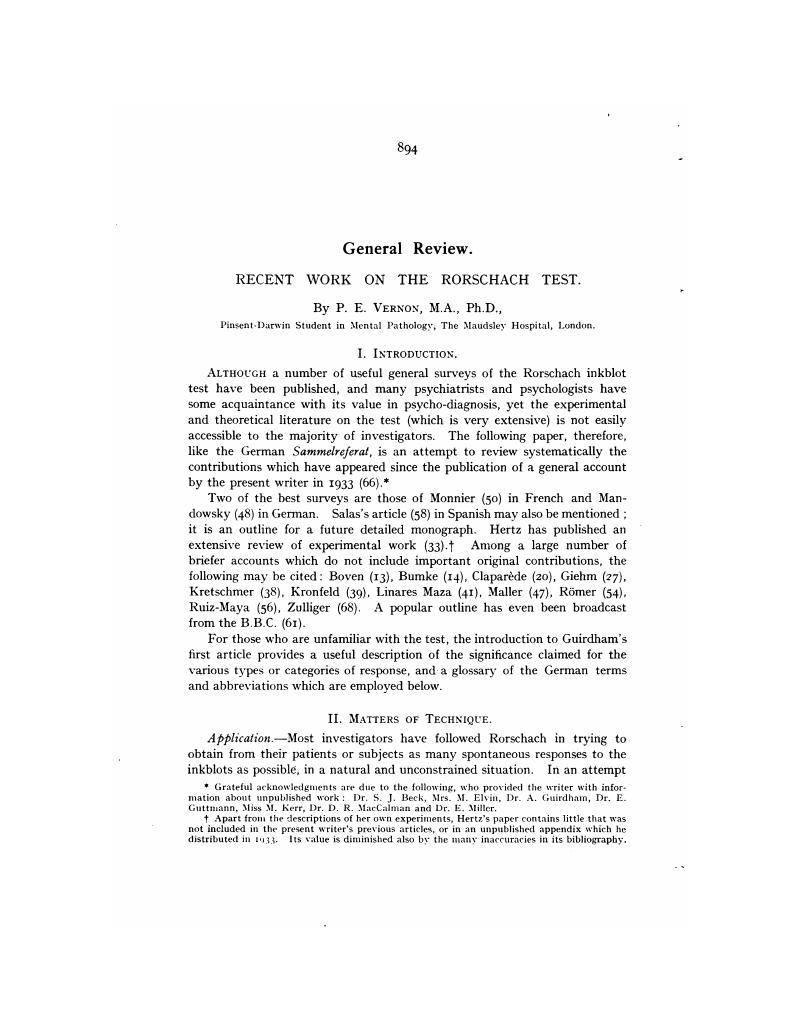Crossref Citations
This article has been cited by the following publications. This list is generated based on data provided by Crossref.
HERTZ, MARGUERITE R
1936.
THE METHOD OF ADMINISTRATION OF THE RORSCHACH INK-BLOT TEST.
Child Development,
Vol. 7,
Issue. 4,
p.
237.
Guttmann, Erich
1936.
Artificial Psychoses Produced by Mescaline.
Journal of Mental Science,
Vol. 82,
Issue. 338,
p.
203.
Guirdham, Arthur
1937.
Epileptic Reactions: An Attempt at Classification.
Journal of Mental Science,
Vol. 83,
Issue. 347,
p.
679.
Binder, Hans
Bleuler, Manfred
Benjamin, John D.
Booth, Gotthard C.
Hertz, Marguerite R.
Klopfer, Bruno
Piotrowski, Zygmunt
Schachtel, Ernst
Hartoch, Anna
Guirdham, Arthur
and
Loosli-Usteri, Marguerite
1937.
Discussion on “Some Reecent Rorschach Problems”.
Rorschach Research Exchange,
Vol. 2,
Issue. 2,
p.
43.
Vernon, P. E.
1937.
Rorschach Bibliography No. III.
Rorschach Research Exchange,
Vol. 1,
Issue. 3,
p.
89.
Benjamin, John D.
and
Ebaugh, Franklin G.
1938.
THE DIAGNOSTIC VALIDITY OF THE RORSCHACH TEST.
American Journal of Psychiatry,
Vol. 94,
Issue. 5,
p.
1163.
Watson, Goodwin
1938.
Chapter VI: Personality and Character Measurement.
Review of Educational Research,
Vol. 8,
Issue. 3,
p.
269.
Piotrowski, Zygmunt
1938.
Blind Analysis of a Case of Compulsion Neurosis.
Rorschach Research Exchange,
Vol. 2,
Issue. 3,
p.
89.
Davidson, Helen H.
and
Klopfer, Bruno
1938.
Rorschach Statistics Part II: Normal Children.
Rorschach Research Exchange,
Vol. 3,
Issue. 1,
p.
37.
Hertz, Marguerite R.
1938.
Scoring the Rorschach test with specific reference to “normal detail” category..
American Journal of Orthopsychiatry,
Vol. 8,
Issue. 1,
p.
100.
Hertz, Marguerite R.
1938.
Scoring the Rorschach Ink-Blot Test.
The Pedagogical Seminary and Journal of Genetic Psychology,
Vol. 52,
Issue. 1,
p.
15.
Hertz, Marguerite R.
1938.
The “Popular” Response Factor in the Rorschach Scoring.
The Journal of Psychology,
Vol. 6,
Issue. 1,
p.
3.
Hunter, Mary
1939.
The practical value of the Rorschach test in a psychological clinic..
American Journal of Orthopsychiatry,
Vol. 9,
Issue. 2,
p.
287.
Hertz, Marguerite R.
and
Rubenstein, Boris B.
1939.
A comparison of three "blind" Rorschach analyses..
American Journal of Orthopsychiatry,
Vol. 9,
Issue. 2,
p.
295.
Hertz, Marguerite R.
1939.
On the Standardization of the Rorschach Method.
Rorschach Research Exchange,
Vol. 3,
Issue. 3,
p.
120.
Krugman, Morris
1940.
Out of the Ink Well.
Rorschach Research Exchange,
Vol. 4,
Issue. 3,
p.
91.
KRUGMAN, MORRIS
1940.
OUT OF THE INKWELL: THE RORSCHACH METHOD*.
Journal of Personality,
Vol. 9,
Issue. 2,
p.
91.
Hertz, Marguerite R.
1940.
The Shading Response in the Rorschach Inkblot Test: A Review of its Scoring and Interpretation.
The Journal of General Psychology,
Vol. 23,
Issue. 1,
p.
123.
Hertz, Marguerite R.
1941.
Rorschach: Twenty Years After.
Rorschach Research Exchange,
Vol. 5,
Issue. 3,
p.
90.
HERTZ, MARGUERITE R.
1941.
EVALUATION OF THE RORSCHACH METHOD IN ITS APPLICATION TO NORMAL CHILDHOOD AND ADOLESCENCE*.
Journal of Personality,
Vol. 10,
Issue. 2,
p.
151.



eLetters
No eLetters have been published for this article.